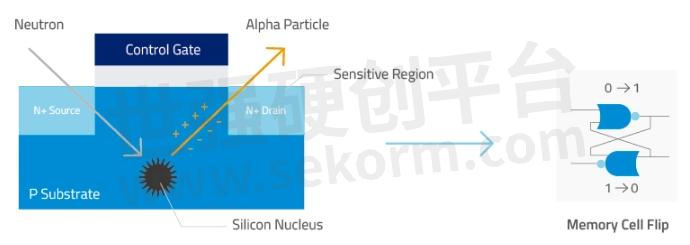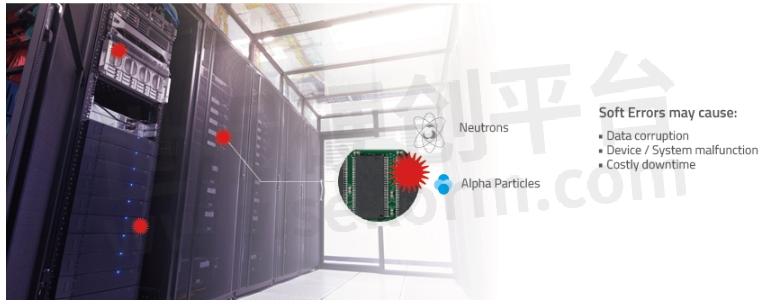What is SRAM Soft Error Detection?




A study conducted by IBM over 20 years ago showed that high-energy nuclear particles cause electronic component "soft" errors. There are two sources of nuclear particles: decaying radioactive atoms existing in trace amounts in all materials and extraterrestrial radioactive cosmic rays cascading through the Earth's atmosphere. When these particles hit a silicon nucleus, it explodes into fragments that generate a stream of electrical charges that can upset any circuit. Any circuit is vulnerable to soft fails due to cosmic rays.
Soft Errors vs. Hard Errors
JEDEC defines soft errors as, " An erroneous output signal from a latch or memory cell that can be corrected by performing one or more normal functions of the device containing the latch or memory cell. As commonly used, the term refers to an error caused by radiation or electromagnetic pulses and not to an error associated with a physical defect introduced during the manufacturing process." Soft errors occur randomly and cause no permanent damage to the memory device.
Hard errors on the other hand are those that "keep recurring as a result of hardware or physical defects on the memory or storage device. Hard memory errors are commonly caused by operating a system beyond the memory's speed capacity and subjecting the system to charges of static electricity. Other causes include environmental factors such as temperature, shock/vibration, electrical/voltage stress or physical stress. Mishandling, aging, or manufacturing defects can also affect the reliability of hardware components. Hard errors are usually permanent and require module replacement."
Causes and Impact of Soft Errors
A soft error, also known as a single-event upset (SEU), is caused by ionizing radiation from cosmic rays and alpha particles. Cosmic rays such as neutrons are high-energy particles from space, which enter the Earth's atmosphere and interact with the air, while alpha particles are from traces of contaminants or radioactive materials in memory chip packages. When these highly charged particles penetrate a memory cell, the state of a bit changes (flips). If the charge is big enough, it can cause multiple cells or bits to be upset.
In systems requiring the highest levels of reliability, alpha particles can be reduced by applying shielding materials or using components that are insensitive to radiation. Neutrons however, can't be shielded – they can penetrate even 5 ft. of concrete!

Figure 1. When radioactive particles such as neutrons from cosmic rays penetrate a silicon nucleus from the substrate, the resulting nuclear reaction fragments the silicon nucleus. The fragments (alpha particles) upset the sensitive region, causing the memory cell to "flip" or change value.
Soft errors are typically resolved by a system reboot. However, because they are random and temporary, it is possible that they go undetected, thus accumulate without the proper action being taken. Below are some effects of soft errors:
Functional interruptions
Read/write errors, data corruption
Device hanging or stops working but resumes after a power cycle
Bricking, or the device stops working even after a power cycle
Data written in the wrong location
Data writing takes longer

Figure 2. Soft errors, also called single-event upsets, occur when highly charged particles such as neutrons and radioactive materials like alpha particles from the environment strike sensitive regions of an electronic device and disrupt its normal operation.
SRAM Vulnerability
The study conducted by Intel showed that electronic failure from cosmic rays increased at elevated altitudes. These days, however, even ground-based devices are at great risk, particularly SRAM-based devices that have high sensitivities to radiation effects. Static Random Access Memory (SRAM) is used as memory cache by the processor. Unlike Dynamic Random Access Memory (DRAM), which requires being constantly refreshed (recharged with power) to keep data, SRAM can store data without frequent refreshing. This means that the processor does not have to wait to access data on the SRAM, resulting in speedier processing. SRAM is very fast, and hence also more expensive than DRAM. The following are common reasons why SRAM is susceptible to soft errors.
Lower Supply Voltage. SRAM voltage goes down with every process generation, resulting in lower cell capacitance (the ability of a cell to store electric charge). This makes the memory cell more vulnerable to getting struck by an alpha particle or cosmic ray.
Scaling. The trend to use more SRAM bits to cut latencies makes SRAM arrays the densest memory on a chip and increases exposure to charged particles.
Packaging. Integrated chips are packaged using materials with small amounts of radioactive contaminants. Trace amounts of Uranium and Thorium for example are found in mold compounds and assembly materials. If the ideal material purity is not maintained, alpha particles can cause soft errors.
The ATP e.MMC SRAM Soft Error Detector and Recovery Mechanism
For some personal devices, the impact of soft errors may be insignificant. However, for mission-critical tasks like financial transactions, traffic control, security/surveillance, even minor glitches can have disastrous effects. Unattended, soft errors can lead to function loss, system failure, and other adverse effects.
The ATP e.MMC advanced SRAM Soft Error Detector and Recovery mechanism maximizes data integrity by providing timely error detection, logging, and configurable action to address the error (configuration is predetermined by the customer with ATP and cannot be changed on the field). If, after assessing the risk, the user opts to continue running the device, an error log and a system reboot should be performed to avoid unpredictable events that could damage the system, or worse, cause personal safety risks in critical autonomous applications.
The following figures show how the e.MMC SRAM Soft Error Detector and Recovery mechanism works.
(Note: Steps may vary depending on pre-determined configuration.)

Figure 3. As soon as an error is detected, the event is logged in the flash. The system can be alerted to handle the error and the firmware may be stopped. The ATP SRAM Soft Error Detector and Recovery Mechanism attempts to correct the error by initiating a system reboot.

Figure 4. If the system reboot fails, the error is considered a "hard error" and the e.MMC should be replaced. If the system reboot succeeds, the error is confirmed to be a "soft error." This means that the reboot has resolved the error and operation can continue with the correct data.
Soft errors can corrupt data and cause systems to malfunction or fail. SRAM is particularly vulnerable; hence, it is important to be able to detect errors that may not have been detected by built-in error-correcting codes. Data integrity and high reliability is of great importance to mission-critical applications such as networking, military, health care, financial services, and more. It is therefore important to ensure that soft errors are not left to worsen as they could damage not only very important data but also physical assets.
- |
- +1 赞 0
- 收藏
- 评论 0
本文由涂抹转载自ATP Blogs,原文标题为:What is SRAM Soft Error Detection?,本站所有转载文章系出于传递更多信息之目的,且明确注明来源,不希望被转载的媒体或个人可与我们联系,我们将立即进行删除处理。
相关推荐
Traffic Control and Bandwidth Allocation of Wireless AC in Intelligent Manufacturing
The traffic control and bandwidth allocation strategy of wireless AC in intelligent manufacturing is of great significance for improving the stability and efficiency of the production network. Through precise traffic control and flexible bandwidth allocation, wireless AC can ensure efficient, stable and secure network communication in the intelligent manufacturing environment, providing strong support for the development of intelligent manufacturing.
ATP(华腾国际)DRAM存储模块和NAND闪存产品选型指南(英文)
Company Profile Segment Challenges and Solutions Thermal Solutions Endurance Solutions Security Solutions CFexpress & USB 3.0 Value Line SSDs DDR5 DRAM SOLUTIONS FLASH SOLUTIONS Flash Products Naming Rule Solutions & Technologies Flash Technology Overview table Complete Flash Spec Overview & Product Dimensions
ATP - ECC SO-DIMM,USB驱动器,MICROSD MEMORY CARDS,MICROSDHC CARD,DDR SO-DIMM,3D TLC SSDS,PCIE®GEN4高容量NVME M.2 2280固态硬盘,PCIE® GEN4 NVME U.2 SSD,SATA III 2.5" SSD,DDR2模块,PCIE® GEN 4 NVME M.2 2280 SSD,SD CARD,SATA III M.2 2280 SSD,PCIE®GEN4 NVME U.2固态硬盘,PCIE® GEN 3 NVME M.2 2280 SSD,NANODURA双通用闪存驱动器(UFD),PCIE®GEN 3 NVME M.2型1620 HSBGA固态硬盘,SD CARDS,CFEXPRESS TYPE B MEMORY CARDS,DRAM,非ECC UDIMM,NVME固态硬盘,SECURSTOR MICROSD CARD,DDR2 MODULES,DDR4 RDIMMS,SATA III MSATA SSD,SSDS,PCIE® GEN 3 NVME M.2 2242 SSD,SD卡,LEGACY (SDR/DDR) DRAM MODULES,ECC UDIMM,NON-ECC UDIMM,PCIE® GEN4 NVME CFEXPRESS CARD,NANODURA双UFD,PCIE® GEN 3,PCIE® GEN 3 NVME M.2 TYPE 1620 HSBGA SSD,SDHC CARD,E.MMC,HIGH-SPEED TYPE B CFEXPRESS CARDS,高速B型CFEXPRESS卡,PCIE® GEN4 HIGH-CAPACITY NVME M.2 2280 SSD,DDR3模块,DDR5 DIMM,MICROSD卡,PCIE®GEN3 NVME U.2固态硬盘,SOLID STATE DRIVES,SDXC卡,DRAM MODULES,SATA III M.2 2242 SSD,PCIE® GEN3 NVME M.2 2242 SSD,NON-ECC SO-DIMM,DUAL-INLINE MEMORY MODULES (DIMMS),CFAST卡,NVME散热器球栅阵列(HSBGA)固态硬盘,PCIE®GEN 3 NVME M.2 2242固态硬盘,SD MEMORY CARDS,MICROSD CARDS,非ECC SO-DIMM,PCIE®GEN 3 NVME M.2 2280固态硬盘,SDHC卡,DDR3 UDIMM,DDR3 MODULES,PCIE® GEN3 NVME M.2 2280 SSD,存储卡,固态硬盘,DDR3 MODULES,SECURSTOR MICROSD卡,MICROSDXC CARD,DDR3 SO-DIMM,NAND FLASH MEMORY,PCIE® GEN3 NVME M.2 2230 SSD,DDR4模块,DDR5 MEMORY,DDR5 DIMMS,WIDE TEMPERATURE RDIMM,HSBGA SSDS,NVME HEAT SINK BALL GRID ARRAY (HSBGA) SSDS,DDR4-3200模块,SDXC CARD,NANODURA DUAL UNIVERSAL FLASH DRIVES (UFDS),SATA III 2.5英寸固态硬盘,DDR4-3200 MODULE,RDIMM,MICROSDHC卡,PCIE® GEN 3 NVME M.2 2230 SSD,DDR4 MODULES,DRAM模块,DDR4宽温度RDIMM,MICROSDXC卡,NVME SSDS,DDR5内存,MEMORY CARDS,NVME M.2 TYPE 1620 HSBGA SSD,SDRAM,DDR5模块,CFEXPRESS CARDS,DDR UDIMM,SATA III M.2 2280固态硬盘,UNIVERSAL FLASH DRIVES,PCIE® GEN3 NVME U.2 SSD,NANODURA DUAL UFDS,DDR1模块,DDR1 MODULES,U.2 SSD,MICROSD CARD,PCIE® GEN3 NVME,USB DRIVES,SOLID STATE DRIVES,SSD,DDR5 MODULES,NAND型闪存,DDR4 RDIMM,COMPACTFLASH CARD,DDR4 WIDE-TEMP RDIMMS,3D TLC固态硬盘,COMPACTFLASH卡,PCIE®GEN4 NVME CFEXPRESS卡,CFEXPRESS B型存储卡,CFAST CARD,PCIE®GEN 3 NVME M.2 2230固态硬盘,SDRAM SO-DIMM,PCIE®GEN 4 NVME M.2 2280固态硬盘,PCIE® GEN4 NVME M.2 2280 SSD,HSBGA固态硬盘,SATA III M.2 2242固态硬盘,A750PI,E650SC SERIES,S600SC,B800PI,S750 SERIES,S600SI,S600SCA,E750PC SERIES,B600SC,N700PC,S700SC,E650SC,A750 SERIES,E600VC,S800PI,A750PI SERIES,I800PI,A600VC,A650SI,A650SC,N700 SERIES,S650SI,N750,N750PI,A800PI,A700PI,N700SI,N650 SERIES,E600SAA,N700SC,A750,N600SC,A600VC SERIES,E600SA,E650SI,E650SI SERIES,N750 SERIES,E700PIA,TR-03153,N600SI,S650,S650SC,E700PAA,N650SIA,E600SI,B600SC SERIES,S750SC,S600SIA,I700SC,N650SI,N600VI,E600SIA,E750PI,N650SC,N750PI SERIES,N600VC,I600SC,E750PC,S700PI,A650 SERIES,N650,N600 SERIES,N600VC SERIES,S650 SERIES,A650,AES-256,E700PI,A600SI,E750PI SERIES,N700PI,E700PA,S750,S750PI,E700PC,A600SC,EDUCATION,汽车,TRANSPORTATION INFRASTRUCTURE,NETWORKING,AUTONOMOUS DRIVING,IN-VEHICLE,DIGITAL VIDEO RECORDERS (DVRS),AUTOMATION,TEST,驱动器记录器,DRIVE RECORDER,数据记录器,EDGE COMPUTING,AUTONOMOUS VEHICLES,能源,TRANSPORTATION SYSTEMS,网络,TEST & MEASUREMENT,工业4.0,无人机,CYBERSECURITY,MEC,自动化,汽车应用,网络安全,WEB SERVER,数据中心,AUTOMOTIVE APPLICATIONS,5G,AUTOMOTIVE,IVI,SD-WAN,EV INFRASTRUCTURE,MEASUREMENT,RAILWAY,电信,MEASURING SYSTEMS,NETWORKING,INDUSTRIAL,无风扇电脑,TRANSPORTATION,IIOT,航空航天,测量系统,车队管理,DATA CENTER,车内,FANLESS PC,TELECOMMUNICATIONS INDUSTRY,IOT,POINT-OF-SALE SYSTEMS(POS),电动汽车基础设施,物联网(IOT),工业物联网,AUTOMOTIVE STORAGE,ENERGY,DEFENSE,FLEET MANAGEMENT,SURVEILLANCE SYSTEMS,交通运输,游戏,铁路,INDUSTRIAL 4.0,工业,国防,自动驾驶,AUTOMATION,INTERNET OF THINGS (IOT),BOX PC,测试,边际运算,测量,INTERNET OF THINGS,DATA LOGGER,NGFW,O-RAN,汽车存储,交通基础设施,TELECOM,INDUSTRIAL,TEST AND MEASUREMENT,教育,AEROSPACE,KIOSK,GAMING,DRONES
ATP(华腾国际)固态硬盘选型指南
Since 1991, we have consistently distinguished ourselves as one of the world’s leading original equipment manufacturers (OEM) of high-performance, high-quality and high-endurance NAND flash products and DRAM modules.
ATP - PCIE®GEN4 X4 M.2 2280,U.2 SSD,PCIE® GEN3 NVME M.2 2230 SSD,DDR5 MEMORY,PCIE®GEN3 NVME M.2 2230固态硬盘,MICROSDHC CARD,PCIE® GEN4 NVME U.2 SSD,SATA III 2.5" SSD,USB DRIVE,SD CARD,SATA III M.2 2280 SSD,SDXC CARD,PCIE®GEN3 NVME M.2 2280固态硬盘,SATA III 2.5英寸固态硬盘,PCIE®GEN4 NVME U.2固态硬盘,USB 2.0 EUSB,CFEXPRESS TYPE B MEMORY CARDS,M.2 TYPE 1620 HSBGA SSD,M.2 2242 SSD,NVME固态硬盘,MICROSDHC卡,PCIE® GEN4 X4 M.2 2280, U.2 SSDS,SECURSTOR MICROSD CARD,MSATA固态硬盘,PCIE® GEN4 NVME E1.S SSD,SATA III MSATA SSD,DRAM模块,PCIE®GEN4 NVME M.2 2280固态硬盘,MICROSDXC卡,NVME SSDS,DDR5内存,PCIE ® GEN4 NVME CFEXPRESS CARD,EMMC,SD卡,PCIE®GEN4 NVME E1.S固态硬盘,DRAM MODULES,M.2 2280固态硬盘,PCIE®GEN3 NVME M.2 2242固态硬盘,PCIE® GEN4 NVME CFEXPRESS CARD,NANODURA双UFD,E1.S PCIE GEN4 X4 SSD,SDHC CARD,袖珍闪存卡,E.MMC,PCIE® GEN3 NVME M.2 TYPE 1620 HSBGA SSD,MICROSD,M.2 2280 SSD,M.2 2230 SSD,SATA III M.2 2280固态硬盘,PCIE® GEN3 NVME U.2 SSD,NANODURA DUAL UFDS,MICROSD卡,CFEXPRESS卡,PCIE®GEN3 NVME U.2固态硬盘,SDXC卡,SATA III M.2 2242 SSD,PCIE® GEN3 NVME M.2 2242 SSD,MICROSD CARD,CFAST卡,1.ES PCIE GEN4 X4固态硬盘,SDHC卡,PCIE®GEN3 NVME M.2型1620 HSBGA固态硬盘,随身碟,CFEXPRESS CARD,COMPACTFLASH CARD,COMPACTFLASH卡,PCIE®GEN4 NVME CFEXPRESS卡,PCIE® GEN3 NVME M.2 2280 SSD,PCIE ® GEN3 NVME M.2 TYPE 1620 HSBGA SSD,EUSB,VALUE LINE SSDS,M.2型1620 HSBGA SSD,CFEXPRESS B型存储卡,CFAST CARD,M.2 2230固态硬盘,价值线固态硬盘,MSATA SSD,SECURSTOR MICROSD卡,PCIE® GEN4 NVME M.2 2280 SSD,MICROSDXC CARD,COMPACT FLASH CARD,M.2 2242固态硬盘,PCIE ® GEN3 NVME U.2 SSD,SATA III M.2 2242固态硬盘,A750PI,S600SC,B800PI,S750 SERIES,S600SI,B600SC,N700PC,A750 SERIES,E650SC,N601,N651SI,A600VI,S800PI,E600VC,I800PI,A600VC,A650SI,A650SC,N651SC,N750,S650SI,A600VI SERIES,N750PI,N651SIE,A800PI,N601 SERIES,A700PI,N651SIA,N650 SERIES,E600SAA,A750,A600VC SERIES,N600SC,E600SA,E650SI,N750 SERIES,E700PIA,N600SI,S650,S650SC,N651SI SERIES,E700PAA,B600SC SERIES,E600SI,N600VI SERIES,I700SC,N600VI,N650SI,E600SIA,N650SC,E750PI,N600VC,I600SC,E750PC,N651,S700PI,A650 SERIES,N650,N751PI,S700PC,N600VC SERIES,N651 SERIES,S650 SERIES,A650,N601SC,S750PC,E700PI,A600SI,N700PI,E700PA,S750,S750PI,E700PC,N651SCE,A600SC,数据记录,伺服器,汽车,AI SURVEILLANCE INFRASTRUCTURES,NETWORKING,ARTIFICIAL INTELLIGENCE (AI)-ENABLED SURVEILLANCE,HANDHELD COMPUTING,工业企业,物联网,手持计算,WEB SERVERS,网络,DATA LOGGING,POINT-OF-SALE (POS) TRANSACTIONS,自动化,IMAGING,企业,5G,STORAGE,成像,POS,销售点(POS)交易,BOX PCS,AUTOMOTIVE,SERVER,电信,ENTERPRISE,TRANSPORTATION,ROBOTICS,IOT,交通运输,SURVEILLANCE,人工智能(AI)监控,盒装PCS,边缘计算系统,工业,机器人学,AUTOMATION,EDGE COMPUTING,MISSION-CRITICAL APPLICATIONS,边际运算,INTERNET OF THINGS,EDGE COMPUTING SYSTEMS,TELECOM,INDUSTRIAL,INDUSTRIAL ENTERPRISE,关键任务应用程序,监控,存储器,人工智能监控基础设施,网络服务器
当最大的或最新的并不总是最好的:2D存储解决方案万岁
该资料主要介绍了ATP Electronics公司生产的SD/microSD卡、e.MMC和SD/SDHC/SDXC卡等存储产品的特性、规格和性能。产品具备防水、防尘、抗静电等特性,支持工业和商业温度范围,具有长达5年的供应周期。资料详细列出了不同产品的性能参数,包括顺序读写速度、功耗、耐用性和可靠性等,并提供了产品尺寸、认证和保修信息。
ATP - SD,MICROSD,E.MMC,COMMERCIAL,INDUSTRIAL,商业的,工业
e.MMC MLC解决方案专业存储和内存解决方案的全球领导者
ATP - E.工业MMC,INDUSTRIAL E.MMC,E.MMC,E700PI,E600SA,E700PIA,E600SIA,E700PA,E600SI,E600SC,E700PAA,E600SAA,E700PC,EMBEDDED SYSTEMS,工业应用,嵌入式系统,INDUSTRIAL APPLICATIONS
Extensive Reliability Tests Prove the Suitability of 3D e.MMC MLC and SLC Mode for Demanding Industrial Automotive Application
Based on the results of the reliability tests, the ATP e.MMC with 3D SLC Mode and MLC NAND flash deliver reliable performance for industrial and automotive applications requiring high density and long endurance.
E700PI系列AF010GEC5A-SEK0111工业级SLC模式e.MMC数据表
本资料为ATP Electronics Inc.生产的工业级SLC模式e.MMC E700Pi系列产品的数据手册。该产品是一款嵌入式存储解决方案,采用MMC接口、闪存和控制器集成在同一IC封装中,适用于嵌入式和商业应用。产品具备高可靠性、高性能、长寿命等特点,支持多种高级功能,如动态数据刷新、自动刷新、SRAM软错误检测和恢复技术等。
ATP - INDUSTRIAL-GRADE SLC MODE E.MMC,INDUSTRIAL-GRADE E.MMC,工业级SLC模式E.MMC,工业级E.MMC,E700PI,E700PI SERIES,AF010GEC5A-SEK0111,COMMERCIAL APPLICATIONS,INDUSTRIAL,商业应用,工业
ATP Electronics to Showcase Latest TSE, PCIe® Gen 4, High-Endurance SSD Solutions for Focused Segments at Embedded World 2023
Also on display at Embedded World 2023 are ATP’s wide range of legacy and latest-generation NAND flash storage solutions in different form factors, endurance ratings, thermal, operating temperature, firmware, and customization options to meet the requirements of industrial and automation systems.
ATP Industrial/automotive-grade e.MMC Designed to High-performance Data Transfer, Achieving with up to 128 GB Of Memory
e.MMC is a universal data storage and communication media and is typically used in portable applications. Its small footprint makes it a preferred choice for mobile devices such as smartphones, tablets and laptops. Increasingly, e.MMC is also gaining wide acceptance in embedded systems for industrial and automotive applications, such as infotainment systems, aerospace/avionics, Internet of Things (IoT), industrial automation, and other applications.
ATP’s Obsolescence Management Strategy Drives Long-Term Supply Stability and Flexibility
Despite its tiny size, which is smaller than a typical postage stamp, the ATP embedded multimedia card or e.MMC packs many premium features for industrial and automotive applications. The ATP e.MMC provides ultra-high endurance and trustworthy performance even under the most rigid operating scenarios.
Showdown Between Consumer & Industrial SSDs
ATP‘s wide range of industrial SSDs is designed for long, reliable performance under heavy workloads and even in the harshest and most demanding environments. As a true manufacturer, ATP manages the stages of the manufacturing process and conducts thorough testing from wafer/IC level to module and product level to ensure that only products of the highest quality are produced from its facilities.
ATP Industrial e.MMC Employs Configurable SRAM Soft Error Detector and Recovery Mechanism, Robust Durability
The ATP industrial e.MMC (Embedded MultiMediaCard) solution is designed to meet the high-performance data transfer and storage requirements of industrial and embedded applications in space-constrained systems requiring rugged reliability and very high endurance.
ATP Electronics Showcases Specialized Storage & Memory Solutions at Electronica 2022
ATP Electronics will be on-site at Electronica 2022. On display at ATP’s booth are customizable thermal, high-endurance, and security solutions as well as the latest showcase of ATP’s industrial memory and storage solutions, such as PCIe Gen. 4 NVMe SSDs, CFexpress cards, and DDR5 memory modules.
ATP‘s PCB Assembly Solderability Validation Tests
ATP’s PCB assembly validation tests are part of the many reliability and endurance tests developed and performed by ATP to ensure strict compliance to the highest standards of quality. ATP is committed to delivering high-performance and high-endurance NAND flashes storage products to ensure the best value for the total cost of ownership (TCO).
ATP SSDs选型表
ATP推出SSDs(固态硬盘),Capacity(存储容量)120G-7680G,Operating Temperature(工作温度)-40℃~85℃
|
产品型号
|
品类
|
Product Line
|
Capacity(GB)
|
Operating Temperature(℃)
|
Power Loss Protection
|
|
FT240GP48APHBPI
|
固态硬盘
|
N651Si
|
240GB
|
-40℃~85℃
|
Hardware + Firmware Based
|
选型表 - ATP 立即选型
电子商城
服务
可定制ATP TE Cooler的冷却功率:40~200W;运行电压:12/24/48V(DC);控温精度:≤±0.1℃; 尺寸:冷面:20*20~500*300;热面:60*60~540*400 (长*宽;单位mm)。
最小起订量: 1 提交需求>




































































































































































































登录 | 立即注册
提交评论